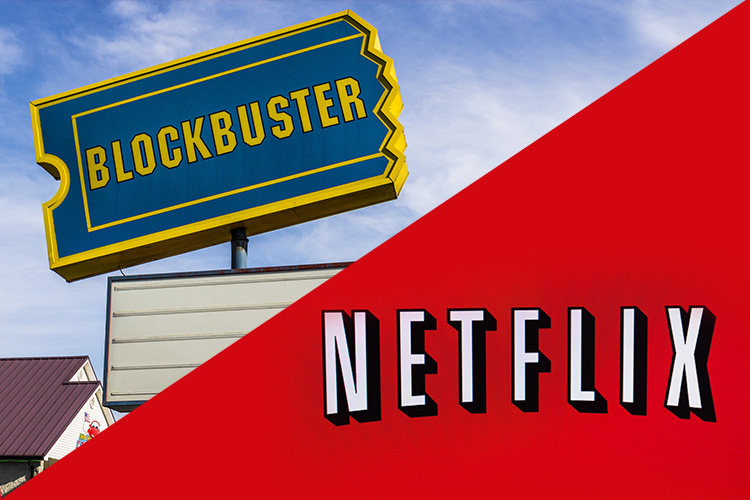Legal Tech and the Changing Legal Services Industry
Weekly Update - March 21

Quote of the Week
“... When I started in this process as a young lawyer, I might go down to the library and bill 10 hours. About two years ago I could do the exact same work on LexisNexis or Westlaw in about an hour. So in essence, my law firm would pay LexisNexis or Westlaw for the privilege of losing nine hours of revenue. Improving the alignment between client and lawyer interests is a fundamental challenge for adopting technology at law firms.”
(Joe Andrew, Global Chair of Dentons)
Three Articles Worth Reading
| Topic | What's the Artice About? | Key Excerpt | Why it Matters |
| Are You Netflix or Blockbuster (Casey Sullivan) | The danger of ignoring changes to the competitive landscape. | In 2008, the Motley Fool asked Blockbuster CEO Jim Keyes how he was responding to his biggest competitors. His answer? Not at all. "Neither RedBox nor Netflix are even on the radar screen in terms of competition," he said. It wasn’t a new attitude, either. Just three years earlier, Keyes’ predecessor passed up the opportunity to buy Netflix, the video-by-mail turned video-by-streaming company with a $94 billion market cap, for a mere $50 million. |
In 1994, Viacom purchased Blockbuster for $8.4 billion. In 2010, Blockbuster declared bankruptcy. In between, Blockbuster made a host of decisions that, in hindsight, were clearly not the right ones. And most crucially, Blockbuster failed to understand and respond to the key threats to its business model. The similarities between Blockbuster and the legal industry are uncanny. The legal industry is undergoing massive change. Demand for services is flat. New competitors (both large and small) are encroaching on what was once the exclusive territory of BigLaw. And new technology is changing the way services are consumed. Firms that recognize (and act on) the need for change can avoid the fate of Blockbuster. Those that confuse their continued profitability with long-term success may be in for a wake-up call down the road. |
| The Law Firm Disrupted: Tales from a Document Automation Specialist (Roy Strom) | The challenges of document automation. |
One barrier is the common perception that a lawyer’s work is too bespoke or unique to be automated. Zaremba said in a recent questionnaire he sent to potential clients, 45 percent of lawyers claimed their work was too unique to benefit from document automation. “They often say their work is unique, but what they’re actually saying is that there are many variables in what I do,” Zaremba said. “The question is not whether this can be automated, but how complex will the automation be?” |
In this fascinating article, Roy Strom profiles Yuriy Zaremba, a lawyer who left his law firm to found a document automation company. As Zaremba points out, there are a number of challenges that firms face when trying to automate documents. First, lawyers don’t want to invest the time to automate, even if it will make their life much easier and save them time in the future. Billable work is seen as the top priority (and most lawyers are incentivized accordingly), which means that tasks like document automation (which pay huge dividends in the long run, but not the short run) are deprioritized. Most firms will need dedicated employees to automate documents, unless the firms are willing to make the necessary incentive changes to encourage this type of behaviour. Second – and perhaps most importantly – lawyers often fail to grasp that their work can be automated. The fact that 45% of lawyers claimed their work was too unique to benefit from document automation is not shocking. Lawyers need to start viewing their decision-making process as a decision tree (and often a very complicated one) and focus on the upsides of automation (going home earlier; making more money; focusing on more interesting things), not the potential downsides. |
| Data and the Impact on Elite Athletes (Michael Grange) | Data, data, data. |
“One of the biggest shocks to the entire industry is shooting it too high [with an arc well above 45 degrees] is just as bad as shooting it flat,” Carter says. “We’ve all been taught to shoot it higher [but] the data doesn’t support [that approach]. If you shoot too high, you will spray it short [or] long; you just can’t control it. Even at the NBA level you have coaches that still believe you can never shoot it too high, and I’ve had to prove these guys wrong and it can be a difficult conversation sometimes…. We know if it was three inches to the left and short. We know if it was right and long. We can see tendencies that the naked eye can’t see … We just have data no one in the world has ever seen before.” |
Firms that leverage data are going to be at a significant advantage to those that don’t. Once again, sports provide a fantastic parallel for some of the changes in the legal industry. In this article from many months ago, Michael Grange took a look at new technology that the Raptors were using to improve their 3-point shooting. The new technology – which is named Noah – tracks every single shot taken in practice and scrimmages and has over 26 million shots in its database (i.e. far more than any human could possibly recall). As expected, the data has proven a number of truisms to be completely false. And as expected, some elite athletes were not easily convinced that this supposed ‘wisdom’ the technology was providing was going to benefit them. To quote DeMar DeRozan in the article, “I don’t use it… I’d get tired of hearing that shit…” Change is tough – especially when the change is contrary to conventional wisdom. But firms that can obtain buy-in, especially from their key partners, will have a huge advantage against their competitors. |



